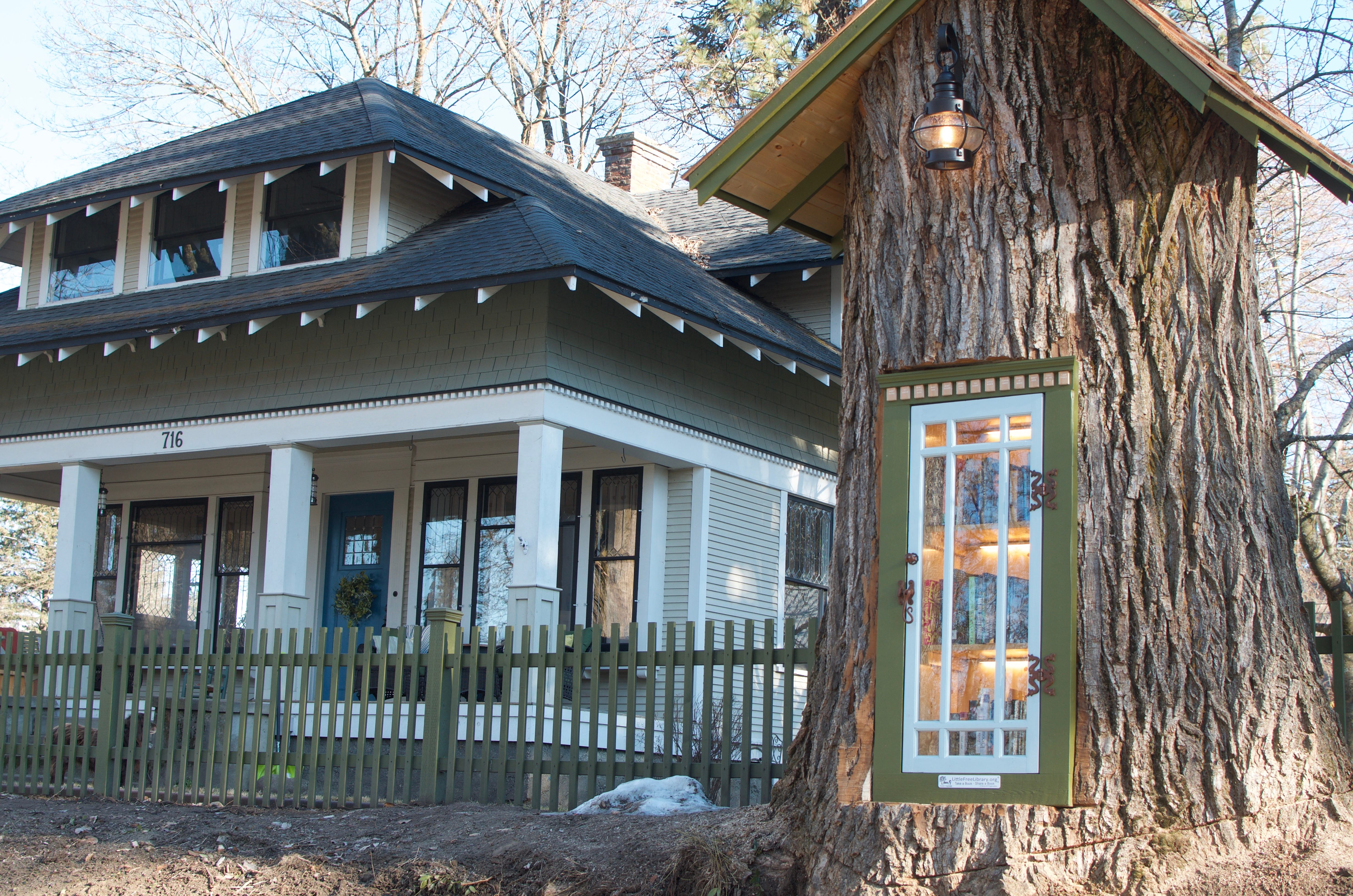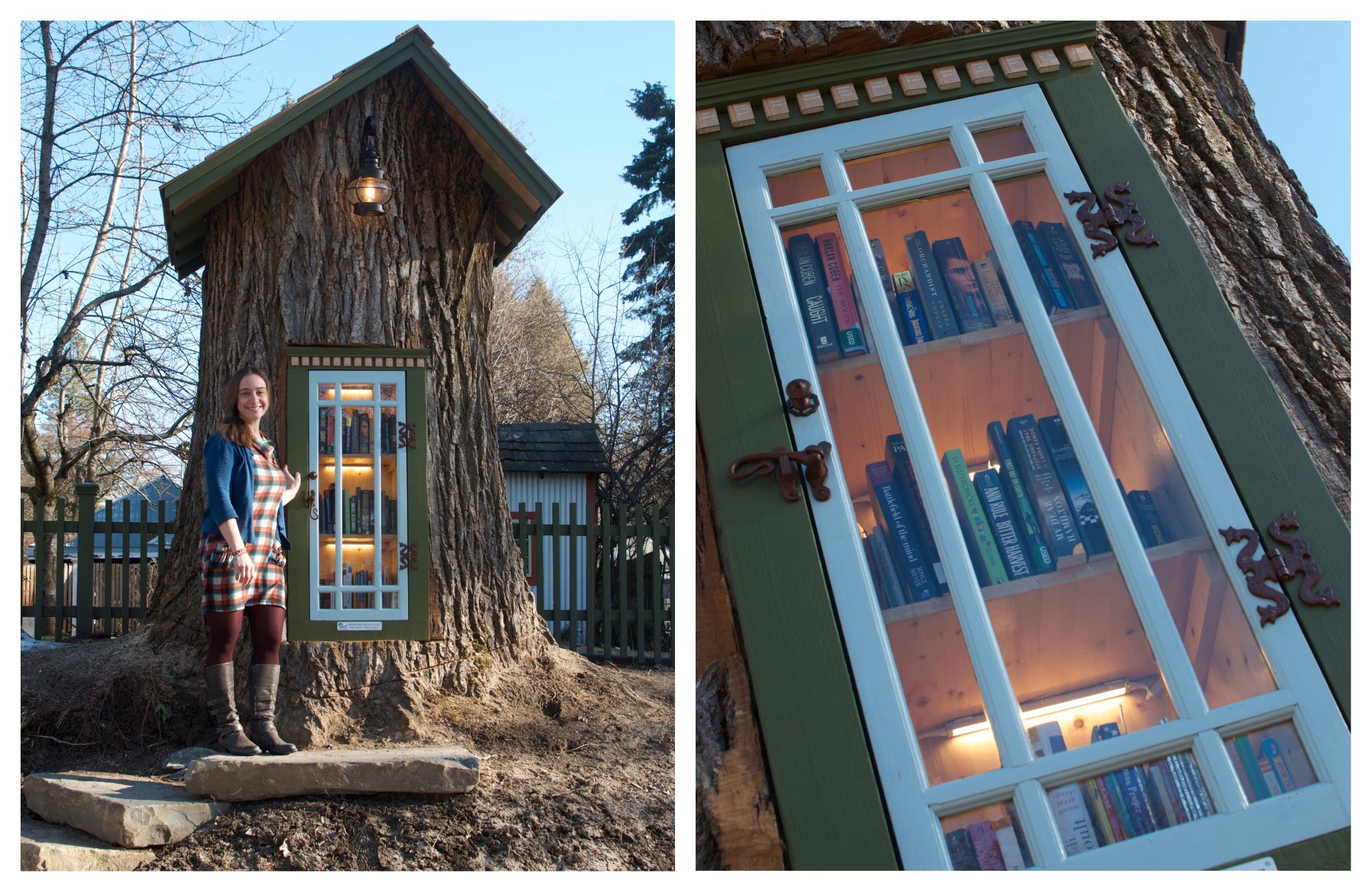The Most Magical ‘Little Free Library’ Is Built Right Into a Tree Stump
A rotting 110-year-old black cottonwood gets a second life.

In the city of Coeur d’Alene, Idaho, known to many as a sleepy lakefront resort town, a woman named Sharalee Armitage Howard has turned a dying 110-year-old black cottonwood tree into a magical library.
Stone steps lead up the sloped front yard to what remains of the tree. The 10-foot-tall trunk has a shingled roof that extends a little over the edges. A lantern-style lamp lights a row of tiny faux wooden books that make up the library’s decorative dentil molding. The real books, however, are visible through a vintage window-turned-door. The door itself features hardware that looks like it would have been at home in Middle Earth.
Although the tree needed to come down, likely since her family had bought the house 15 years ago, Howard says that she had a hard time letting go. In November 2018, after a branch dropped onto her son’s car, the end finally arrived. Once Howard saw inside the tree, it was clear that the inner wood had rotted.
But even then, Howard hoped to give the stump another life. “I thought: What if I kept the trunk part of it? What if we make it into one of those Little Free Libraries?” she says. “Immediately I could envision the little steps going up to it. I knew I’d do a lot of features to make it match the house. You just have these ‘what if’ moments and then your brain starts figuring out how to make it work.”

The Little Free Library movement, which was founded in 2009 by the late Todd H. Bol in Wisconsin, was intended to promote literacy and community with the “take a book, share a book” concept. With over 75,000 Little Free Libraries in 88 countries, the idea has taken off, though it’s not without its critics.
Howard, who works for the Coeur d’Alene Public Library, has been interested in Little Free Libraries for a long time, even creating a freestanding one a few years ago as an auction item for her children’s school. Like the tree version, that library included tiny decorative books (she had the school kids select their favorites). “I bid on it until I couldn’t afford it anymore because I really wanted it,” she says.
For her tree library, Howard created an insert—essentially a box—which would fit inside the hole in the stump. That box became the functional part of the library, into which shelving and books were ultimately placed.
Meanwhile, her husband and four children selected the titles for the row of ornamental books. There are classics including Call of the Wild, Nancy Drew, and The Grapes of Wrath, along with contemporary favorites such as Hush Little Alien, Harry Potter, and Percy Jackson. Each faux book was limited to three lines with seven letters per line.

Although she still planned to add some finishing touches, Howard shared her creation on Facebook on December 10, 2018. Local media outlets quickly picked up the story, and over the next month, national publications followed. Since then, Howard’s library has been busy. “There’s been a steady stream of cars,” she says. “There’s literally been people waiting for other people to take their turn.”
Though this is Howard’s best known project, the library is only one of her book- and community-related artistic endeavors.
Years ago, in a quest to create a children’s book to connect far-away relatives, Howard became interested in bookbinding. Unsatisfied with the options available at office supply stores, she began looking into techniques for doing it herself. That passion eventually led to a low-residency degree program in fine binding at the American Academy of Bookbinding in Telluride, Colorado. Currently, she’s binding a copy of Call of the Wild and she’s almost done with Walt Whitman’s Leaves of Grass, which includes grass-shaped insets.

In the fall of 2018, Howard created a dress and hat (a birdcage with a bird inside) entirely out of unsalvageable books as part of local non-profit Kootenai Environmental Alliance’s annual “Junk to Funk” fundraiser. Each year, they ask different artists to create garments out of recycled materials. Howard frequently makes items for fundraisers in the community, many of them book-themed.
Beyond making books and other art, Howard is passionate about teaching local children about the process as well. She’s been an artist-in-residence at her children’s K-6 school for the arts and humanities several times, often leading the kids through the process of writing, illustrating, and assembling books before selling them at the Farmer’s Market to benefit humanitarian causes that they have decided on in advance. In the past, the kids have chosen to build wells in Ethiopia, send school supplies and desks to Tanzania, and buy bikes for a local organization who uses them to harvest food from community gardens. “I wanted to show them that at any age you can do something that solves a problem and you can use the arts to do that,” says Howard.
For Howard, the Little Free Library’s purpose is primarily to delight. “Some people think it’s just for kids, but I think adults are just as excited to stumble across a Little Free Library and find something that they want to read. It lets you be a kid,” she says. “It didn’t need to be done. The tree didn’t need to be repurposed, but it’s magic.”



















Follow us on Twitter to get the latest on the world's hidden wonders.
Like us on Facebook to get the latest on the world's hidden wonders.
Follow us on Twitter Like us on Facebook